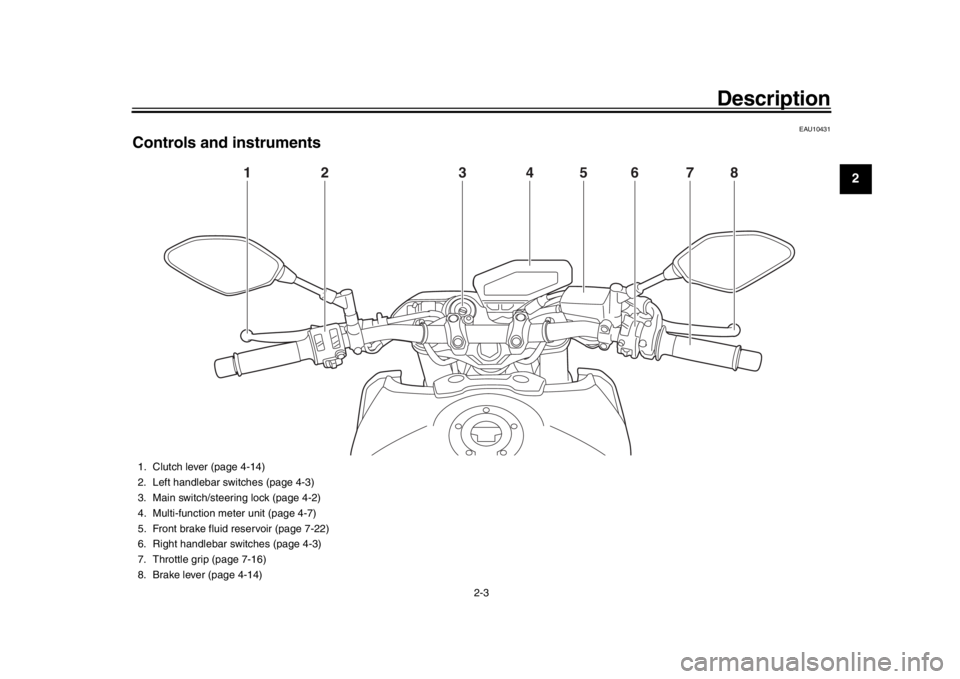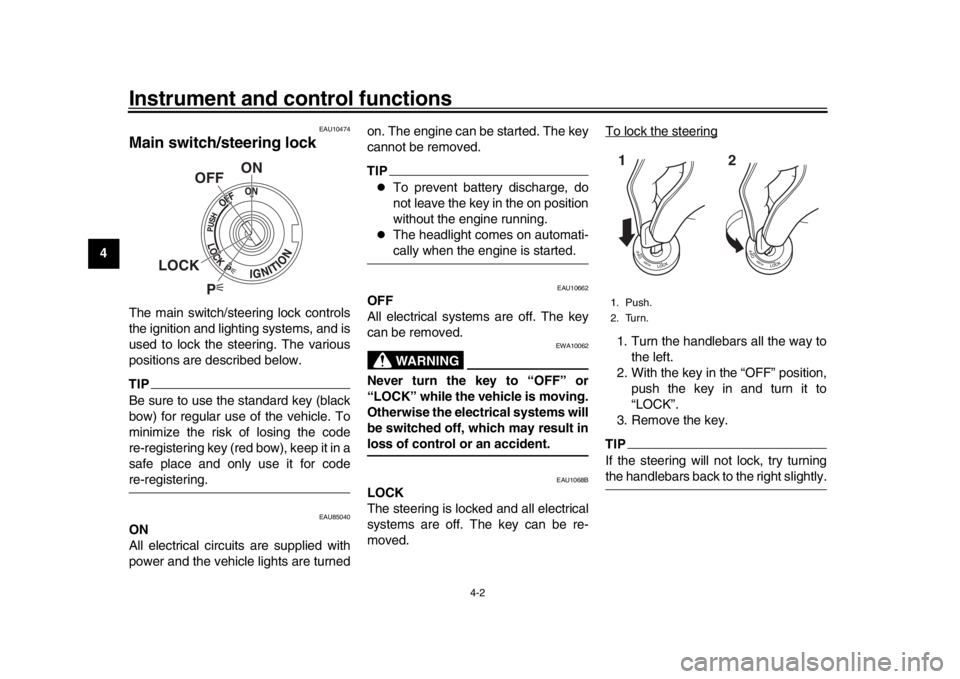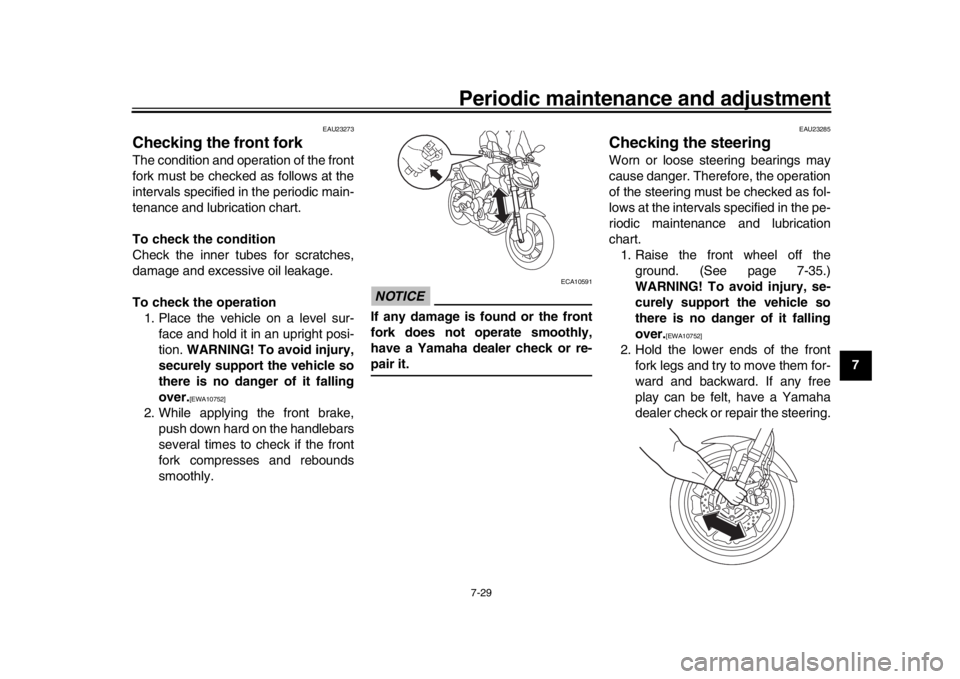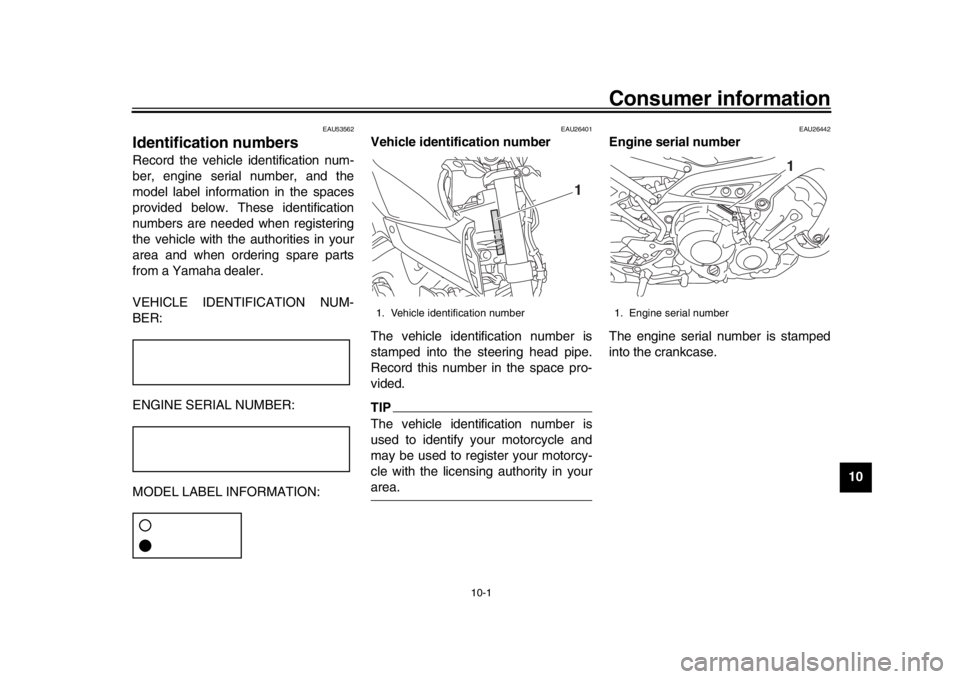steering YAMAHA MT-09 2019 Owners Manual
[x] Cancel search | Manufacturer: YAMAHA, Model Year: 2019, Model line: MT-09, Model: YAMAHA MT-09 2019Pages: 104, PDF Size: 7.14 MB
Page 6 of 104

Table of contentsSafety information........................... 1-1
Description ....................................... 2-1
Left view ......................................... 2-1
Right view ....................................... 2-2
Controls and instruments................ 2-3
Special features ............................... 3-1
D-mode (drive mode)...................... 3-1
Traction control system .................. 3-1
Quick shift system ...... .................... 3-3
Instrument and co ntrol functions... 4-1
Immobilizer system ..... .................... 4-1
Main switch/steering lock................ 4-2
Handlebar switches ........................ 4-3
Indicator lights and warning lights ............................................ 4-5
Multi-function meter unit ................. 4-7
Clutch lever................................... 4-14
Shift pedal..... ............................ .... 4-14
Brake lever ................................... 4-14
Brake pedal .................................. 4-15
ABS .............................................. 4-15
Fuel tank cap ................................ 4-16
Fuel............................................... 4-17
Fuel tank overflow hose................ 4-19
Catalytic converter ........................ 4-19
Seat .............................................. 4-20
Storage compartment ................... 4-20
Adjusting the front fork.................. 4-21 Adjusting the shock absorber
assembly................................... 4-23
Luggage strap holders . ................ 4-24
Auxiliary DC connectors ............... 4-25
Sidestand ..................................... 4-25
Ignition circuit cut- off system ........ 4-26
For your safety – pre-operation
checks .............................................. 5-1
Operation and important riding
points ................................................ 6-1
Starting the engine ......................... 6-1
Shifting ........................................... 6-2
Tips for reducing fuel consumption ............................... 6-3
Engine break-in .............................. 6-3
Parking ........................................... 6-4
Periodic maintenance and
adjustment ....................................... 7-1
Tool kit............................................ 7-2
Periodic maintenance charts .......... 7-3
Periodic maintenance chart for the emission control system ............. 7-3
General maintenance and lubrication chart .......................... 7-5
Removing and installing the
panel ........................................... 7-9
Checking the spark plugs ............. 7-10
Canister ........................................ 7-11 Engine oil ..................................... 7-11
Why Yamalube ............................ 7-14
Coolant ........................................ 7-14
Air filter element ........................... 7-16
Checking the engine idling
speed............ ............................ 7-16
Checking the throttle grip free play ........................................... 7-16
Valve clearance ........................... 7-17
Tires ............................................. 7-17
Cast wheels ................................. 7-19
Adjusting the clutch lever free play ........................................... 7-20
Checking the brake lever free
play ........................................... 7-20
Brake light switches ..................... 7-21
Checking the front and rear
brake pads................................ 7-21
Checking the brake fluid level ...... 7-22
Changing the brake fluid .............. 7-23
Drive chain slack.......................... 7-24
Cleaning and lubricating the drive chain ................................ 7-25
Checking and lubricating the cables ....................................... 7-26
Checking and lubricating the throttle grip and cable ............... 7-26
Checking and lubricating the
brake and shift pedals .............. 7-27
Checking and lubricating the brake and clutch levers ............ 7-27BS2-9-E2.book 1 ページ 2018年8月10日 金曜日 午前9時36分
Page 7 of 104

Table of contents
Checking and lubricating the sidestand................................... 7-28
Lubricating the swingarm pivots ... 7-28
Checking the front fork ................. 7-29
Checking the steering . .................. 7-29
Checking the wheel bearings ....... 7-30
Battery .......................................... 7-30
Replacing the fuses ...................... 7-31
Vehicle lights ................................ 7-34
Replacing a turn signal light bulb ........................................... 7-34
Supporting the motor cycle............ 7-35
Troubleshooting............................ 7-35
Troubleshooting charts ................. 7-37
Motorcycle care and storage .......... 8-1
Matte color caution ......................... 8-1
Care................................................ 8-1
Storage ........................................... 8-3
Specifications .................................. 9-1
Consumer information .................. 10-1
Identification numbers .................. 10-1
Diagnostic connector ... ................. 10-2
Vehicle data recordin g.................. 10-2
Index ............................................... 11-1
BS2-9-E2.book 2 ページ 2018年8月10日 金曜日 午前9時36分
Page 10 of 104

Safety information
1-3
1
2
3
4
5
6
7
8
9
10
11
12 MENT.
Do not run engine indoors. Even if
you try to ventilate engine exhaust
with fans or open windows and
doors, carbon monoxide can rap-
idly reach dangerous levels.
Do not run engine in poorly venti-
lated or partially enclosed areas
such as barns, garages, or car-
ports.
Do not run engine outdoors where
engine exhaust can be drawn into
a building through openings such
as windows and doors.
Loading
Adding accessories or cargo to your
motorcycle can adversely affect stabili-
ty and handling if the weight distribution
of the motorcycle is changed. To avoid
the possibility of an accident, use ex-
treme caution when adding cargo or
accessories to your motorcycle. Use
extra care when riding a motorcycle
that has added cargo or accessories.
Here, along with the information about
accessories below, are some general
guidelines to follow if loading cargo to
your motorcycle: The total weight of the operator, pas-
senger, accessories and cargo must
not exceed the maximum load limit.
Operation of an overloaded vehicle
could cause an accident.
When loading within this weight limit,
keep the following in mind:
Cargo and accessory weight
should be kept as low and close to
the motorcycle as possible. Se-
curely pack your heaviest items as
close to the center of the vehicle as
possible and make sure to distrib-
ute the weight as evenly as possi-
ble on both sides of the motorcycle
to minimize imbalance or instabili-
ty.
Shifting weights can create a sud-
den imbalance. Make sure that ac-
cessories and cargo are securely
attached to the motorcycle before
riding. Check accessory mounts
and cargo restraints frequently.
Properly adjust the suspension
for your load (suspension-ad- justable models only), and
check the condition and pres-
sure of your tires.
Never attach any large or heavy items to the handlebar, front
fork, or front fender. These
items, including such cargo as
sleeping bags, duffel bags, or
tents, can create unstable han-
dling or a slow steering re-
sponse.
This vehicle is not designed to
pull a trailer or to be attached to
a sidecar.
Genuine Yamaha Accessories
Choosing accessories for your vehicle
is an important decision. Genuine
Yamaha accessories, which are avail-
able only from a Yamaha dealer, have
been designed, tested, and approved
by Yamaha for use on your vehicle.
Many companies with no connection to
Yamaha manufacture parts and acces-
sories or offer other modifications for
Yamaha vehicles. Yamaha is not in a
position to test the products that these
aftermarket companies produce.
Therefore, Yamaha can neither en-
Maximum load: 174 kg (384 lb)
BS2-9-E2.book 3 ページ 2018年8月10日 金曜日 午前9時36分
Page 11 of 104

Safety information
1-4
12
3
4
5
6
7
8
9
10
11
12
dorse nor recommend the use of ac-
cessories not sold by Yamaha or
modifications not specifically recom-
mended by Yamaha, even if sold and
installed by a Yamaha dealer.
Aftermarket Parts, Accessories,
and Modifications
While you may find aftermarket prod-
ucts similar in design and quality to
genuine Yamaha accessories, recog-
nize that some aftermarket accessories
or modifications are not suitable be-
cause of potential safety hazards to you
or others. Installing aftermarket prod-
ucts or having other modifications per-
formed to your vehicle that change any
of the vehicle’s design or operation
characteristics can put you and others
at greater risk of serious injury or death.
You are responsible for injuries related
to changes in the vehicle.
Keep the following guidelines in mind,
as well as those provided under “Load-
ing” when mounting accessories.
Never install accessories or carry
cargo that would impair the perfor-
mance of your motorcycle. Care-
fully inspect the accessory before using it to make sure that it does
not in any way reduce ground
clearance or cornering clearance,
limit suspension travel, steering
travel or control operation, or ob-
scure lights or reflectors.
Accessories fitted to the handle-
bar or the front fork area can
create instability due to improper
weight distribution or aerody-
namic changes. If accessories
are added to the handlebar or
front fork area, they must be as
lightweight as possible and
should be kept to a minimum.
Bulky or large accessories may seriously affect the stability of
the motorcycle due to aerody-
namic effects. Wind may at-
tempt to lift the motorcycle, or
the motorcycle may become un-
stable in cross winds. These ac-
cessories may also cause
instability when passing or being
passed by large vehicles.
Certain accessories can dis- place the operator from his or
her normal riding position. This
improper position limits the free- dom of movement of the opera-
tor and may limit control ability,
therefore, such accessories are
not recommended.
Use caution when adding electri-
cal accessories. If electrical acces-
sories exceed the capacity of the
motorcycle’s electrical system, an
electric failure could result, which
could cause a dangerous loss of
lights or engine power.
Aftermarket Tires and Rims
The tires and rims that came with your
motorcycle were designed to match the
performance capabilities and to provide
the best combination of handling, brak-
ing, and comfort. Other tires, rims, siz-
es, and combinations may not be
appropriate. See page 7-17 for tire
specifications and for information on
servicing and replacing your tires.
Transporting the Motorcycle
Be sure to observe following instruc-
tions before transporting the motorcy-
cle in another vehicle.
Remove all loose items from the
motorcycle.
BS2-9-E2.book 4 ページ 2018年8月10日 金曜日 午前9時36分
Page 15 of 104

Description
2-3
123
4
5
6
7
8
9
10
11
12
EAU10431
Controls and instruments
1
2
3
4
5
6
7
8
1. Clutch lever (page 4-14)
2. Left handlebar switches (page 4-3)
3. Main switch/steering lock (page 4-2)
4. Multi-function meter unit (page 4-7)
5. Front brake fluid reservoir (page 7-22)
6. Right handlebar switches (page 4-3)
7. Throttle grip (page 7-16)
8. Brake lever (page 4-14)
BS2-9-E2.book 3 ページ 2018年8月10日 金曜日 午前9時36分
Page 20 of 104

Instrument and control functions
4-2
1
2
34
5
6
7
8
9
10
11
12
EAU10474
Main switch/steering lockThe main switch/steering lock controls
the ignition and lighting systems, and is
used to lock the steering. The various
positions are described below.TIPBe sure to use the standard key (black
bow) for regular use of the vehicle. To
minimize the risk of losing the code
re-registering key (red bow), keep it in a
safe place and only use it for codere-registering.
EAU85040
ON
All electrical circui ts are supplied with
power and the vehicle lights are turned on. The engine can be started. The key
cannot be removed.
TIP
To prevent battery discharge, do
not leave the key in the on position
without the engine running.
The headlight comes on automati-cally when the engine is started.
EAU10662
OFF
All electrical systems are off. The key
can be removed.
WARNING
EWA10062
Never turn the key to “OFF” or
“LOCK” while the vehicle is moving.
Otherwise the electrical systems will
be switched off, which may result inloss of control or an accident.
EAU1068B
LOCK
The steering is lock
ed and all electrical
systems are off. The key can be re-
moved. To lock the steering
1. Turn the handlebars all the way to
the left.
2. With the key in the “OFF” position, push the key in and turn it to
“LOCK”.
3. Remove the key.TIPIf the steering will not lock, try turningthe handlebars back to the right slightly.
P
ON
OFF
LOCK
1. Push.
2. Turn.12
BS2-9-E2.book 2 ページ 2018年8月10日 金曜日 午前9時36分
Page 21 of 104

Instrument and control functions
4-3
1
2
345
6
7
8
9
10
11
12
To unlock the steering
From the “LOCK” position, push the
key in and turn it to “OFF”.
EAU59680
(Parking)
The hazard lights and turn signal lights
can be turned on, but all other electrical
systems are off. The key can be re-
moved.
The steering must be locked before the
key can be turned to “ ”.NOTICE
ECA20760
Using the hazard or turn signal
lights for an extended length of time
may cause the battery to discharge.
EAU66055
Handlebar switchesLeft
1. Push.
2. Turn.12
1. Pass switch “ ”
2. Dimmer switch “ / ”
3. Turn signal switch “ / ”
4. Horn switch “ ”
5. Traction control system switch “TCS”
2341 5
BS2-9-E2.book 3 ページ 2018年8月10日 金曜日 午前9時36分
Page 58 of 104

Periodic maintenance and adjustment
7-6
1
2
3
4
5
67
8
9
10
11
12
12 Drive chain Check chain slack, alignment and
condition.
Adjust and lubricate chain with a special O-ring chain lubricant
thoroughly. Every 1000 km (600 mi) and after washing the motorcycle, riding in the rain or
riding in wet areas
13 *Steering bearings Check bearing assemblies for
looseness.
Moderately repack with lithium-soap-based grease.
14 *Chassis fasteners Make sure that all nuts, bolts and
screws are properly tightened.
15 Brake lever pivot
shaft Lubricate with silicone grease.
16 Brake pedal pivot
shaft Lubricate with lithium-soap-based
grease.
17 Clutch lever pivot
shaft Lubricate with lithium-soap-based
grease.
18 Shift pedal pivot
shaft Lubricate with lithium-soap-based
grease.
19 Sidestand Check operation.
Lubricate with lithium-soap-based
grease.
20 *Sidestand switch Check operation and replace if
necessary.
21 *Front fork Check operation and for oil
leakage.
Replace if necessary.
22 *Shock absorber
assembly Check operation and for oil
leakage.
Replace if necessary.
NO. ITEM CHECK OR MAINTENANCE JOB
ODOMETER READING
ANNUAL
CHECK
1000 km
(600 mi) 10000 km
(6000 mi) 20000 km
(12000 mi) 30000 km
(18000 mi) 40000 km
(24000 mi)BS2-9-E2.book 6 ページ 2018年8月10日 金曜日 午前9時36分
Page 81 of 104

Periodic maintenance and adjustment7-29
1
2
3
4
5
678
9
10
11
12
EAU23273
Checking the front forkThe condition and operation of the front
fork must be checked as follows at the
intervals specified in the periodic main-
tenance and lubrication chart.
To check the condition
Check the inner tubes for scratches,
damage and excessive oil leakage.
To check the operation 1. Place the vehicle on a level sur- face and hold it in an upright posi-
tion. WARNING! To avoid injury,
securely support the vehicle so
there is no danger of it falling
over.
[EWA10752]
2. While applying the front brake, push down hard on the handlebars
several times to check if the front
fork compresses and rebounds
smoothly.
NOTICE
ECA10591
If any damage is found or the front
fork does not operate smoothly,
have a Yamaha dealer check or re-pair it.
EAU23285
Checking the steeringWorn or loose steering bearings may
cause danger. Therefore, the operation
of the steering must be checked as fol-
lows at the intervals specified in the pe-
riodic maintenance and lubrication
chart.1. Raise the front wheel off the ground. (See page 7-35.)
WARNING! To avoid injury, se-
curely support the vehicle so
there is no danger of it falling
over.
[EWA10752]
2. Hold the lower ends of the frontfork legs and try to move them for-
ward and backward. If any free
play can be felt, have a Yamaha
dealer check or repair the steering.
BS2-9-E2.book 29 ページ 2018年8月10日 金曜日 午前9時36分
Page 97 of 104

10-1
1
2
3
4
5
6
7
8
91011
12
Consumer information
EAU53562
Identification numbersRecord the vehicle identification num-
ber, engine serial number, and the
model label information in the spaces
provided below. These identification
numbers are needed when registering
the vehicle with the authorities in your
area and when ordering spare parts
from a Yamaha dealer.
VEHICLE IDENTIFICATION NUM-
BER:
ENGINE SERIAL NUMBER:
MODEL LABEL INFORMATION:
EAU26401
Vehicle identification number
The vehicle identification number is
stamped into the steering head pipe.
Record this number in the space pro-
vided.TIPThe vehicle identification number is
used to identify your motorcycle and
may be used to register your motorcy-
cle with the licensing authority in yourarea.
EAU26442
Engine serial number
The engine serial number is stamped
into the crankcase.
1. Vehicle identification number
1
1. Engine serial number
1
BS2-9-E2.book 1 ページ 2018年8月10日 金曜日 午前9時36分